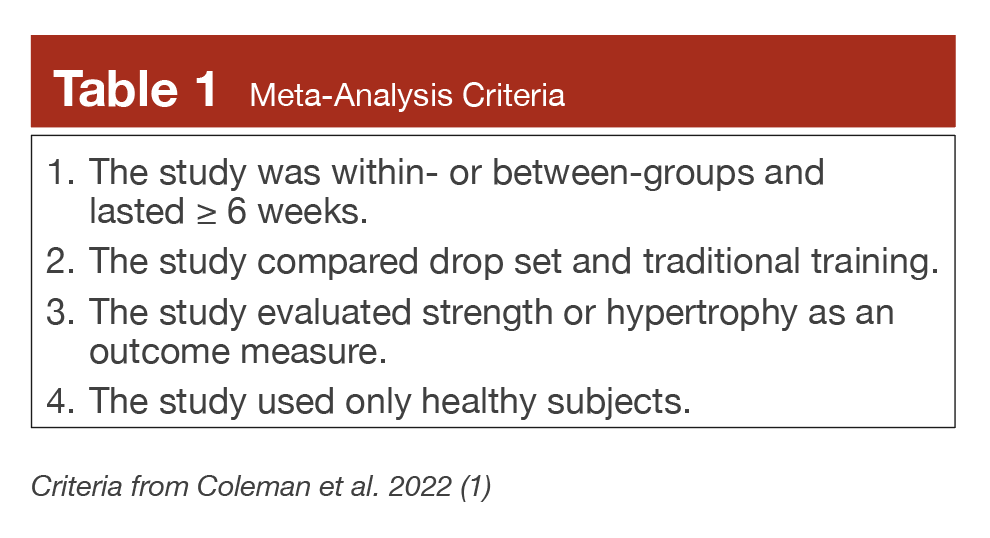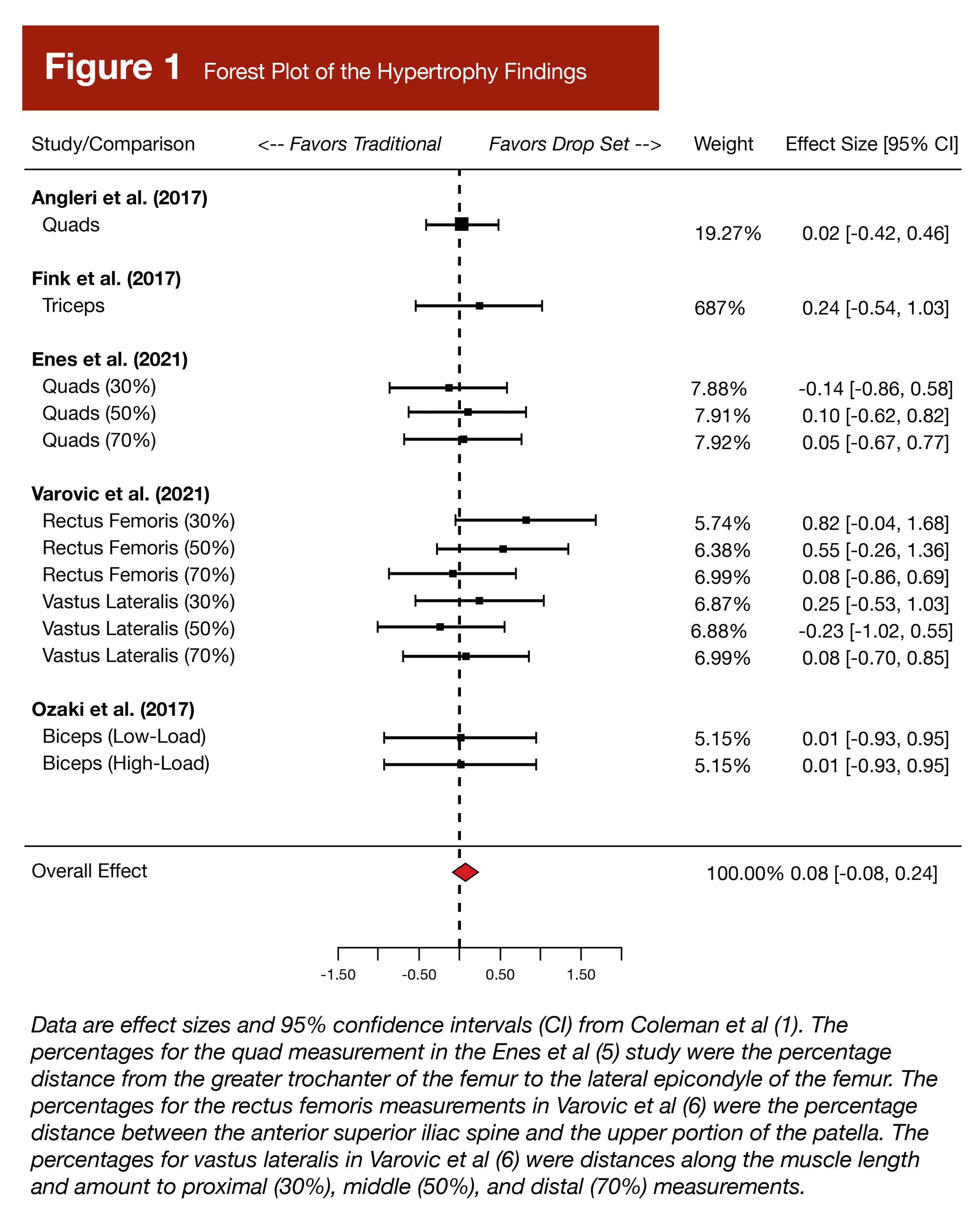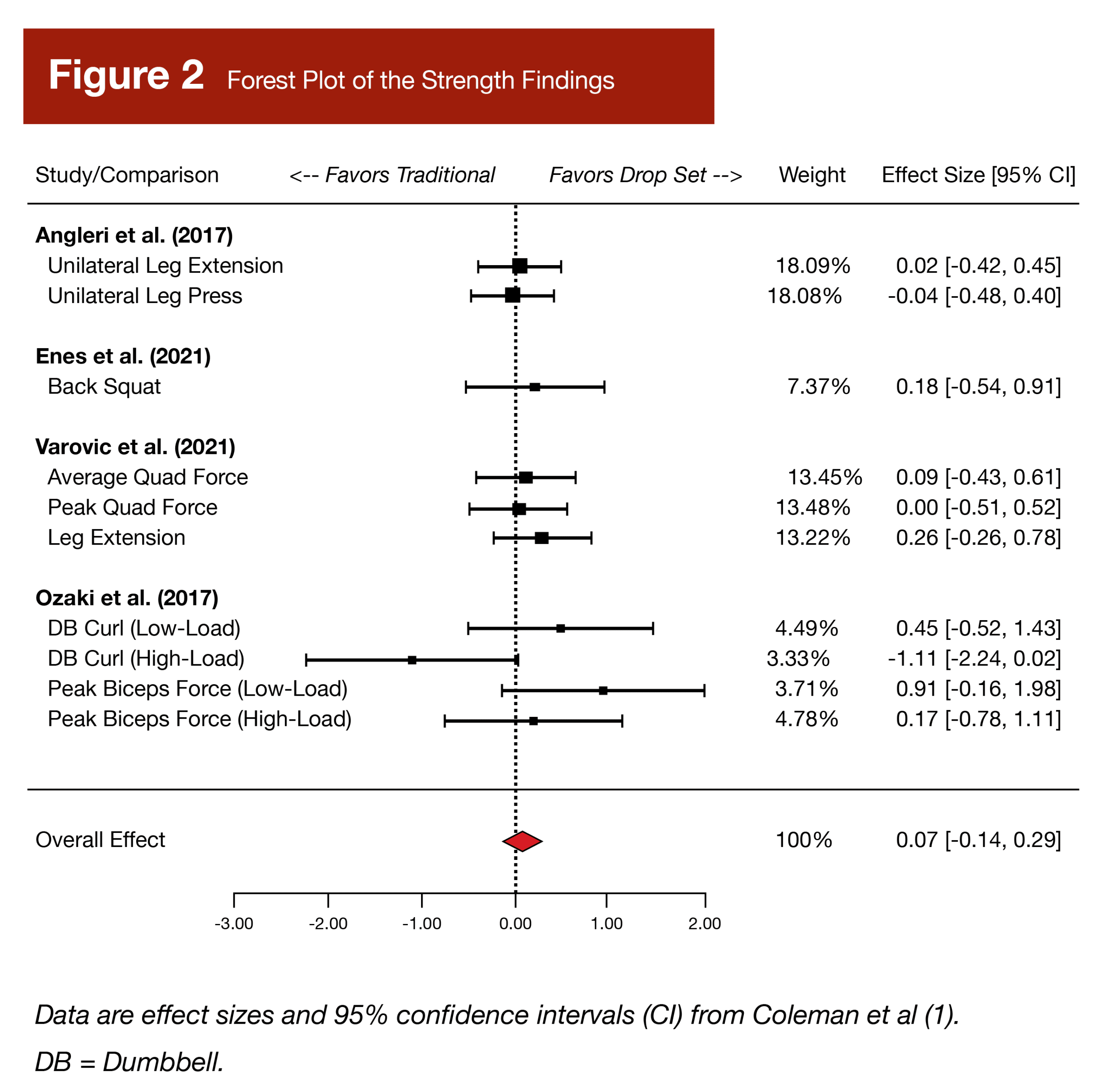Note: This article was the MASS Research Review cover story for February 2023 and is a review of a recent paper by Coleman et al. If you want more content like this, subscribe to MASS.
Key Points
- Researchers conducted a meta-analysis to compare the magnitude of hypertrophy and strength gains between drop set training and traditional set training.
- Findings showed only trivial effect sizes (ES) slightly favoring drop sets for both hypertrophy (ES = 0.08) and strength gains (ES = 0.07), indicating that the drop sets and traditional sets were similarly effective.
- Although this meta-analysis reports similar effectiveness for traditional sets and drop sets, this article proposes why traditional sets may be favorable for strength gains, and discusses the importance of considering individual responses when deciding whether or not to include drop sets in your training program.
I’ve always liked drop sets. They don’t take long, you get a great pump, and they are super fun with a training buddy. In fact, this describes most of my and my buddy Greg’s (a different Greg) time spent lifting weights in his basement 20 years ago. Drop sets, rest-pause sets, and super sets are training in the rawest form, and they remind me of a time when I didn’t think too much and just put my head down and lifted weights. Further, as I wrote about recently, a certain mystique surrounds these strategies. Although most individual studies (2, 3, 4, 5) have shown muscle growth to be similar between drop sets and traditional sets, there is some evidence hinting at a slight advantage for drop sets (6), which has kept their mythical existence alive. Fortunately, a meta-analysis has arrived to provide some authority on the topic.
Purpose and Hypotheses
Purpose
The purpose of the reviewed meta-analysis was to compare drop set training to traditional set training for longitudinal gains in strength and hypertrophy.
Hypotheses
As is customary in a meta-analysis, the researchers did not state any hypotheses.
Methods
Coleman et al (1) systematically searched PubMed/Medline, Web of Science, and CINAHL databases to identify longitudinal studies comparing drop set training to traditional set training for either hypertrophy or strength outcomes. The researchers conducted the meta-analysis following the Preferred Reporting Items for Systematic Reviews and Meta-Analyses (PRISMA) guidelines and pooled the findings of the included studies for analysis. The researchers criteria for including studies in the analysis are in Table 1.

Coleman et al (1) identified five studies (2, 3, 4, 5, 6) that met their inclusion criteria. Of these studies, all five assessed hypertrophy, and four (2, 4, 5, 6) assessed strength. In total, there were 13 comparisons for hypertrophy and 11 comparisons for strength. The researchers rated study quality using the “Downs and Black” checklist (7), which consists of 27 items. Each item was scored as 0 (criteria not satisfied) or 1 (criteria satisfied), and studies were scored as good, moderate, or poor quality if they received 21-29, 11-20, or ≤10 points, respectively. The average score was 18.4 points with two studies scored as “good” and three studies as “moderate” quality.
Analysis
The researchers did not use null hypothesis testing (i.e., no p-values) and instead calculated effect sizes [(mean change 1 – mean change 2) / pooled baseline standard deviation] to compare hypertrophy and strength outcomes between drop set and traditional training. The researchers also completed a “leave one out’ analysis, in which each individual study was removed from the analysis one at a time to see the influence of each study on the findings. Lastly, the I2 statistic was calculated. This statistic quantifies the degree of heterogeneity (variation in effect size estimates among studies) that is not due to sampling error. The I2 is reported as a percentage (Low = <25%; Moderate = 25-75%; High = >75%).
Findings
Out of the five studies and 13 comparisons, the between-group effect size for hypertrophy was trivial (ES = 0.08; 95% Confidence Interval = -0.08 – 0.24). Similarly, the four studies and 11 comparisons for strength resulted in a trivial effect size (ES = 0.07; 95% Confidence Interval = -0.14 – 0.29) when comparing drop sets to traditional set training. The relative degree of observed heterogeneity was quite low for both the hypertrophy and the strength comparisons (I2 = 0%). Lastly, no study in the “leave-one-out” analysis led to an “appreciable difference” in the findings. Forest plots for the hypertrophy and strength findings can be seen in Figures 1 and 2, respectively.


Interpretation
Overall, the Coleman et al (1) meta-analysis found that drop set and traditional training led to a similar degree of hypertrophy and strength gains, as evidenced by the trivial between-group effect sizes. I mostly feel comfortable with that conclusion, but there are four areas that I would like to elaborate on throughout this interpretation:
- Long-term strength gains are probably better with traditional training than with drop sets.
- The individual response to drop set training.
- Drop sets and the perceptual response.
- Drop sets are not a standalone training programming method.
To understand why I want to highlight these four points, Table 2 breaks down the five studies (Table 2) included in the meta-analysis.

Table 2 is mostly full of null findings. Further, many of the between-group percentage differences are pretty close, which shouldn’t be surprising given the trivial effect sizes in the meta-analysis. The general takeaway is that, on average, traditional training and drop sets result in similar strength gains and hypertrophy. However, let’s now consider the four points I noted earlier, beginning with my assertion that traditional training is probably superior to drop sets for strength gains over the long term.
Longitudinal Strength Gains
One reason for suggesting that drop sets are inferior for long-term strength gains is because the strength data from Fink et al (3) was not included in the meta-analysis, and this data showed triceps pushdown 12RM to increase 9.1% more with traditional training than with drop set training. The authors did not specify why this comparison was omitted, but I suspect they viewed the 12RM test as a muscular endurance test rather than a strength test.
Further, in a within-subjects design, Ozaki et al (4) reported significantly greater increases in 1RM biceps curl (+9.5%) with high-load traditional sets than drop sets. Importantly, the peak relative intensity (percentage of 1RM) lifted was 80% of 1RM in Ozaki et al in that comparison. In the Forest plot in Table 2, two other comparisons favor drop sets for strength gains from Ozaki et al. However, those two data points compare drop sets (peak relative intensity = 80% of 1RM) to low-load training (peak relative intensity = 30% of 1RM). Therefore, when peak relative intensity was equated, traditional sets produced greater strength gains in Ozaki et al.
When considering that high-load training led to greater strength gains than drop sets in Ozaki et al and the omitted data from Fink et al, there is justification to suggest that traditional sets are superior for strength gains. Moreover, traditional sets are more likely to have a higher average relative load than drop sets over multiple sets. Traditional sets are also more likely to be trained shy of failure than drop sets (i.e., have a lower velocity loss and more RIR). Further, on exercises commonly used to develop specific strength with a high skill component (i.e., squat, bench press, and deadlift) the quality of later sets may decrease with drop sets due to training in a highly fatigued state with little to no interset rest. Therefore, over the long-term, I suggest using drop sets to supplement training, not as the primary training method, if strength is the main goal.
Individual Responses
Despite the meta-analysis’ general takeaway that strength gains are similar between drop sets and traditional sets, I don’t think that tells the whole story since we must consider the individual response with any comparison. In a between-subjects design, Enes et al (5) reported a range of leg press 1RM increases of 2.3% – 27.0% in the drop set group and 4.5% – 18.0% in the traditional group. These findings demonstrate that not all individuals responded well to the training type they were assigned. Fortunately, three studies (2, 4, 6) included in the reviewed meta-analysis used a within-subjects design where one limb was assigned to drop sets, and the other to traditional training. I’ve written about this in-depth before, but in brief, with a within-subjects design, it can be ascertained how an individual would respond to both protocols. However, in a between-subjects design, such as Enes et al., we only know that there was a wide range of responses and cannot ascertain if someone who did not respond well (i.e., +2.3% strength gains) would have responded better to the other protocol.
Of the three studies with a within-subjects design, one (2) reported how specific individuals did in each condition. Angleri et al (2) found that although there was no significant difference at the group level for hypertrophy or strength gains between drop set and traditional set protocols, five out of 16 subjects gained more leg press strength with traditional training, and two subjects gained more strength with drop set training. That’s 7 out of 16 subjects, or ~44%, who benefited more from one protocol than the other. Angleri et al also reported that three subjects experienced more vastus lateralis hypertrophy with traditional sets, while two subjects benefited more from drop sets.
Drop Sets and the Perceptual Response
Similar to the individual response, downstream effects of a protocol, such as perceived difficulty, should also be considered. For example, Fink et al (3) found that subjects self-reported a significantly higher session RPE following a drop set training session (7.7 ± 1.5) than a traditional training session (5.3 ± 1.4). Importantly, volume load and the peak relative intensity (75% of 1RM) were equal between training groups; thus, I’d wager the reason for the higher session RPE was because the drop set group took all sets to failure with little to no interset rest.
If two protocols offer a similar training response and one is more fatiguing, you get more bang for your buck with the less fatiguing protocol. It’s analogous to using a practical and cheap recovery option such as foam rolling instead of a time-consuming and more expensive option like cold water immersion or cryotherapy. Although we lack direct evidence connecting session RPE to long-term resistance training adherence, long-term engagement in physical activity has been associated with ratings of pleasure following acute exercise (8), and a positive feeling following aerobic exercise has been associated with greater intention to exercise (9).
I’d be remiss not to state that the aforementioned Fink et al study (3) compared a training session of only drop sets to a training session of only traditional sets. While I think using solely drop sets for every training session is not a long-term recipe for adherence, I don’t think the more common approach of using traditional sets and finishing the session by running the rack on dumbbell curls is going to spike session RPE or decrease adherence. If anything, including drop sets on assistance movements toward the end of a workout may be enjoyable for many.
Drop Sets as a Standalone Training Strategy
As should be apparent from the end of the previous section, I don’t view drop sets as a standalone training method. Rather, drop sets, along with rest-pause, cluster, and super sets, are training strategies that should be incorporated at the appropriate time within an otherwise sound training program. To understand when to use drop sets, it’s necessary to ask: what is the point of using drop sets? I addressed that question in-depth in this article, but in brief, drop sets are a training strategy used to accumulate volume in a short period of time. Based upon that understanding, it doesn’t make sense to perform a bunch of drop sets a week or two out from a powerlifting meet or a gym test day since volume is usually trending downward (i.e., tapering) a week or so before testing strength. Instead, drop sets are good strategies to include in volume blocks, situations where a lifter is short on time, or as “exercise snacks.”
Drop sets are also better suited for some exercises than others. For example, always training squats with drop sets would be very fatiguing and may result in technique breaking down due to the lack of interset rest. On the other hand, lifters could implement drop sets more frequently on biceps curls and triceps extensions. Practically, it’s simpler to finish a set of curls, put the weights down (or throw them down to look super tough), and pick up dumbbells 5kg lighter than it is to rack the barbell on squats, change the weight, and squat again. This example isn’t to say that a lifter shouldn’t ever do drop sets on squats; it’s just that I would use drop sets more on assistance exercises.
There are various ways to program drop sets. As outlined in the latter portion of Table 3, lifters can train drop sets to failure or shy of failure. Drop sets can be used as the sole prescription for a particular exercise or as an add-on. To utilize drop sets as the sole prescription, a lifter could perform one set of dumbbell curls for 10 reps, then drop the weight by 10kg and perform 10-15 more reps, then proceed to drop the weight by 2.5-5kg three more times and perform 10-15 reps. However, drop sets can also be performed as a single drop set following traditional sets. For instance, if a lifter bench pressed 3 ´ 8 at 85kg, they could immediately drop the weight to 50kg after the third set and perform a set at or near failure. Specific situations in which lifters might implement drop sets and further examples of how to program drop sets are in Table 3. Additionally, these videos (one, two) provide additional examples of including drop sets (and other training strategies) when in a time crunch.

Next Steps
I’d like to see a longitudinal study comparing the addition of a single drop set after the last set of squats and the last set of curls to just doing traditional sets. Specifically, one group would train with a typical prescription, such as 3 × 10 at 70% of 1RM, and the other group would also do 3 × 10 at 70% and then immediately drop the load to a weight in which failure occurs at 15-20 reps. This study would evaluate if adding a single drop set to upper and lower body exercises and multi-joint and single-joint exercises enhances hypertrophy and strength. I also would deliberately not equate volume between groups since when lifters perform a drop set like this, the choice is usually to either perform the single drop set or stop training. Furthermore, lifters don’t usually consider performing an extra traditional set in lieu of the drop set; thus, I would aim for ecological validity over equating volume. Of course, an even better design would be a third group that trained traditionally and with equated volume compared to the drop set group, but that takes additional time, people, and money.
Application and Takeaways
- This meta-analysis found that drop sets and traditional set training produce similar hypertrophy and strength gains.
- Despite the findings of the meta-analysis, there may be better long-term approaches than drop sets for maximizing 1RM strength. Drop sets are not well-suited as a standalone training method, especially for major exercises like squats, bench presses, and deadlifts.
- Lifters should mostly implement drop sets as a secondary training strategy to accumulate volume in a time-efficient manner. Lifters can implement drop sets by performing 3-5 drop sets back-to-back, or one final drop set following traditional sets. Ultimately, all iterations of drop sets are appropriate as long as they are included as a supplementary component of a well-designed training program.
Get more articles like this
This article was the cover story for the February 2023 issue of MASS Research Review. If you’d like to read the full, 100-page February issue (and dive into the MASS archives), you can subscribe to MASS here.
Subscribers get a new edition of MASS each month. Each edition is available on our member website as well as in a beautiful, magazine-style PDF and contains at least 5 full-length articles (like this one), 2 videos, and 8 Research Brief articles.
Subscribing is also a great way to support the work we do here on Stronger By Science.
References
- Coleman M, Harrison K, Arias R, Johnson E, Grgic J, Orazem J, Schoenfeld B. Muscular Adaptations in Drop Set vs. Traditional Training: A meta-analysis. International Journal of Strength and Conditioning. 2022 Nov 28;2(1).
- Angleri V, Ugrinowitsch C, Libardi CA. Crescent pyramid and drop-set systems do not promote greater strength gains, muscle hypertrophy, and changes on muscle architecture compared with traditional resistance training in well-trained men. European journal of applied physiology. 2017 Feb;117(2):359-69.
- Fink J, Schoenfeld BJ, Kikuchi N, Nakazato K. Effects of drop set resistance training on acute stress indicators and long-term muscle hypertrophy and strength. J Sports Med Phys Fitness. 2018 May 1;58(5):597-605.
- Ozaki H, Kubota A, Natsume T, Loenneke JP, Abe T, Machida S, Naito H. Effects of drop sets with resistance training on increases in muscle CSA, strength, and endurance: a pilot study. Journal of sports sciences. 2018 Mar 19;36(6):691-6.
- Enes A, Alves RC, Schoenfeld BJ, Oneda G, Perin SC, Trindade TB, Prestes J, Souza-Junior TP. Rest-pause and drop-set training elicit similar strength and hypertrophy adaptations compared with traditional sets in resistance-trained males. Applied Physiology, Nutrition, and Metabolism. 2021;46(11):1417-24.
- Varović D, Žganjer K, Vuk S, Schoenfeld BJ. Drop-Set training elicits differential increases in non-uniform hypertrophy of the quadriceps in leg extension exercise. Sports. 2021 Aug 29;9(9):119.
- Downs SH, Black N. The feasibility of creating a checklist for the assessment of the methodological quality both of randomised and non-randomised studies of health care interventions. Journal of Epidemiology & Community Health. 1998 Jun 1;52(6):377-84.
- Williams DM, Dunsiger S, Ciccolo JT, Lewis BA, Albrecht AE, Marcus BH. Acute affective response to a moderate-intensity exercise stimulus predicts physical activity participation 6 and 12 months later. Psychology of sport and exercise. 2008 May 1;9(3):231-45.
- Kwan BM, Bryan AD. Affective response to exercise as a component of exercise motivation: Attitudes, norms, self-efficacy, and temporal stability of intentions. Psychology of Sport and Exercise. 2010 Jan 1;11(1):71-9.




